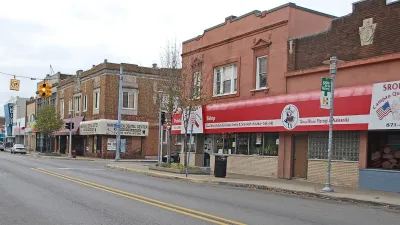A new study, "Community Design, Street Networks, and Public Health" published in the Journal of Transport & Health finds that increased local street connectivity improves public health outcomes, apparently by encouraging more walking and cycling.

A new article, "Community Design, Street Networks, and Public Health," by professors Wesley Marshall, Daniel Piatkowski and Norman Garrick and published in the Journal of Transport & Health, finds that increased neighborhood street connectivity improves public health outcomes, apparently by encouraging more walking and cycling.
The study analyzed the street connectivity and intersection density of 24 medium-size California cities, and used health-survey data from a sampling of 42,000 to 51,000 adults for the years 2003, 2005, 2007 and 2009 to see how the intersection design affects various health outcomes. It controlled for the food environment, land uses, commuting time, socioeconomic status, and street design. The results suggest that more compact and connected street networks with fewer lanes on the major roads are correlated with reduced rates of obesity, diabetes, high blood pressure, and heart disease among residents..
This provides more evidence of the health and safety benefits of more compact, accessible and walkable communities.
Well done, Wesley, Daniel and Norman!
FULL STORY: Walkable cities mean lower obesity and disease rates, says CU Denver study

Alabama: Trump Terminates Settlements for Black Communities Harmed By Raw Sewage
Trump deemed the landmark civil rights agreement “illegal DEI and environmental justice policy.”

Study: Maui’s Plan to Convert Vacation Rentals to Long-Term Housing Could Cause Nearly $1 Billion Economic Loss
The plan would reduce visitor accommodation by 25% resulting in 1,900 jobs lost.

Why Should We Subsidize Public Transportation?
Many public transit agencies face financial stress due to rising costs, declining fare revenue, and declining subsidies. Transit advocates must provide a strong business case for increasing public transit funding.

Wind Energy on the Rise Despite Federal Policy Reversal
The Trump administration is revoking federal support for renewable energy, but demand for new projects continues unabated.

Passengers Flock to Caltrain After Electrification
The new electric trains are running faster and more reliably, leading to strong ridership growth on the Bay Area rail system.

Texas Churches Rally Behind ‘Yes in God’s Back Yard’ Legislation
Religious leaders want the state to reduce zoning regulations to streamline leasing church-owned land to housing developers.
Urban Design for Planners 1: Software Tools
This six-course series explores essential urban design concepts using open source software and equips planners with the tools they need to participate fully in the urban design process.
Planning for Universal Design
Learn the tools for implementing Universal Design in planning regulations.
Caltrans
Smith Gee Studio
Institute for Housing and Urban Development Studies (IHS)
City of Grandview
Harvard GSD Executive Education
Toledo-Lucas County Plan Commissions
Salt Lake City
NYU Wagner Graduate School of Public Service





























